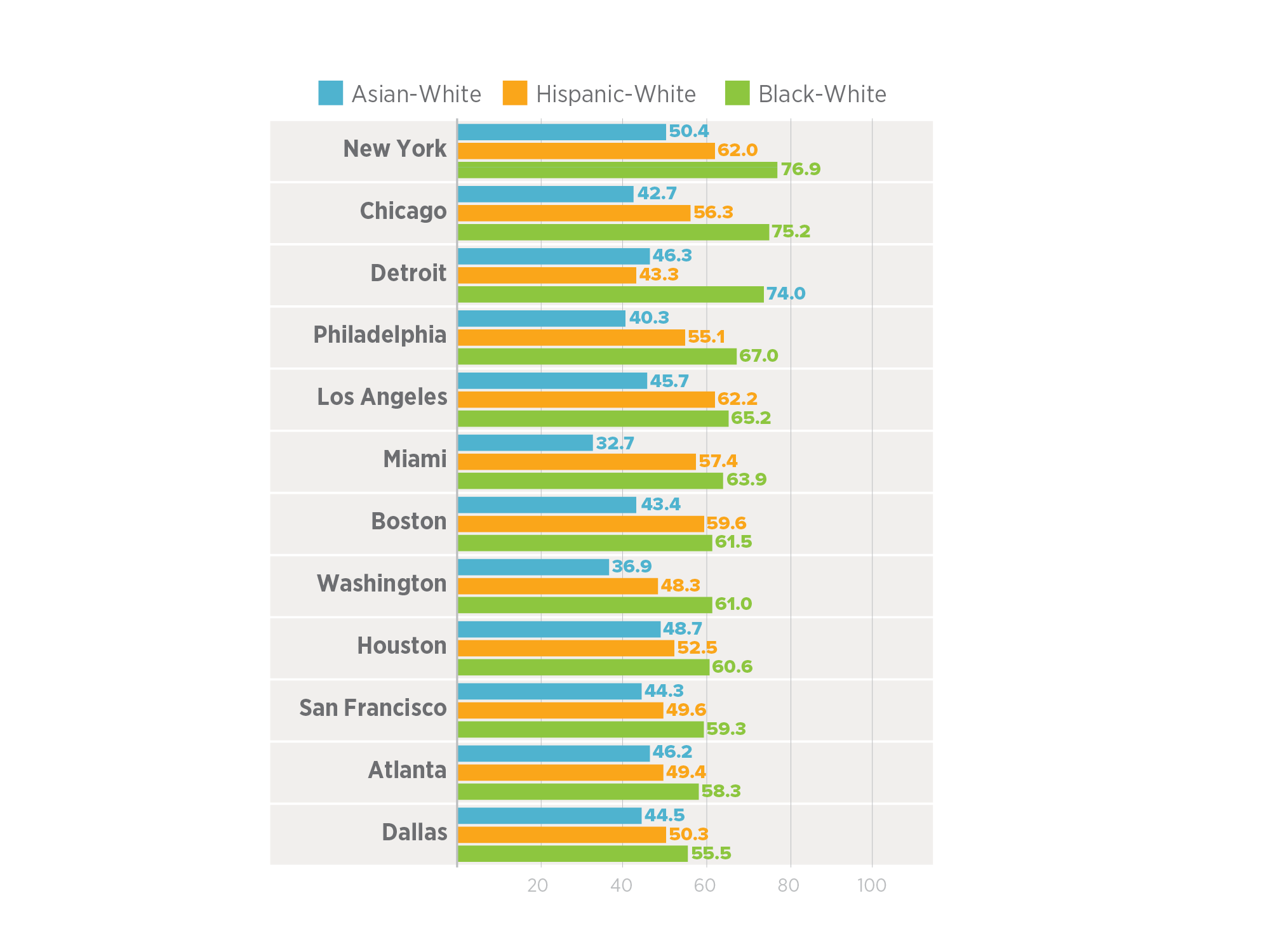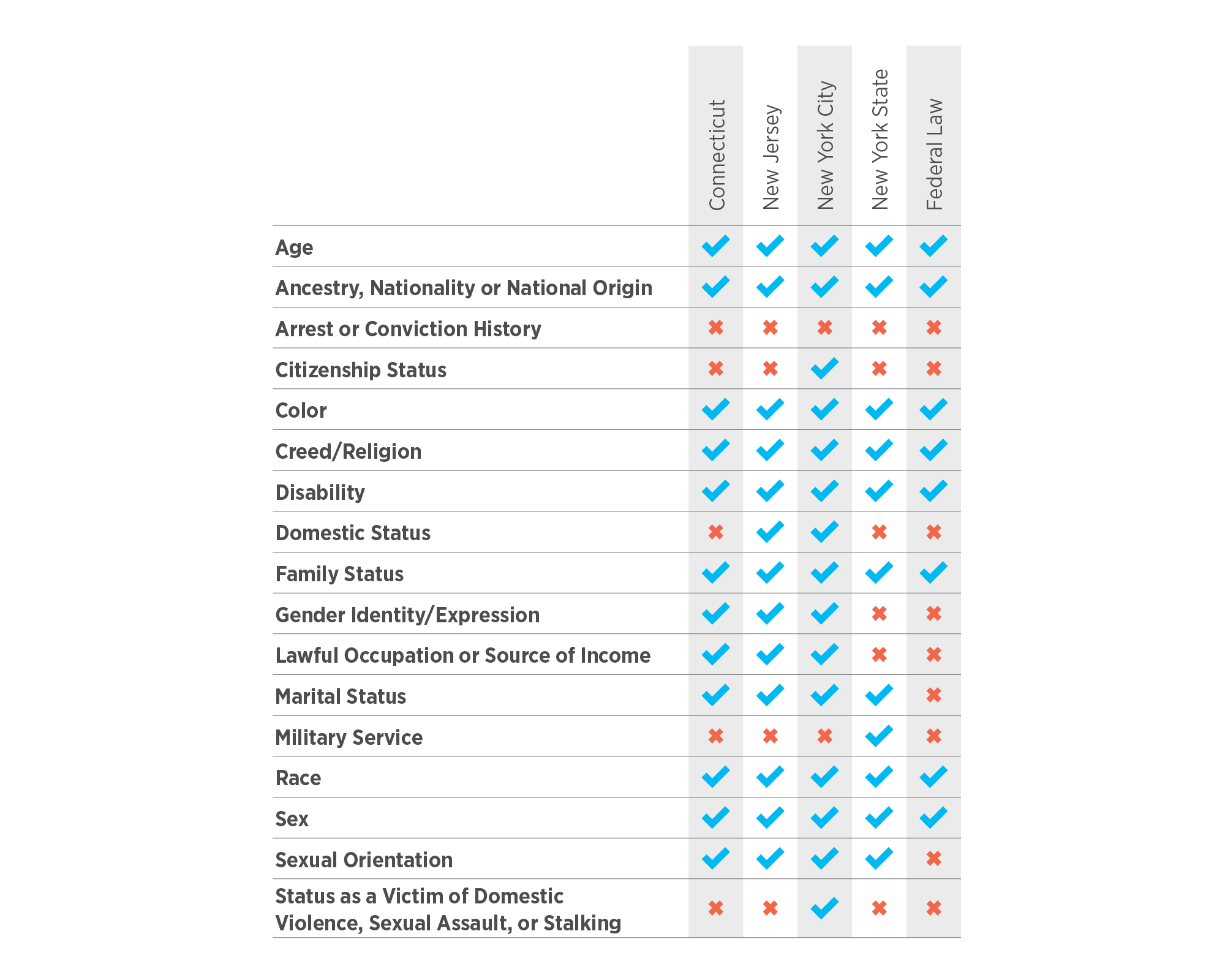
Even though housing discrimination and the mechanisms used to enforce it—including redlining, restrictive covenants, racial steering, and exclusionary zoning—have been outlawed since the 1960s, its legacy persists. Today, the New York region continues to rank as one of the most racially and economically segregated metropolitan areas in the United States. While racial and ethnic segregation in the region has decreased in the last two decades, segregation by income has increased.
The federal Fair Housing Act makes it unlawful to refuse to sell or rent to someone on the basis of race, color, religion, sex, familial status, or national origin. Many communities in the tri-state region have adopted fair housing protections that go beyond those set by the federal government. New York, New Jersey, and Connecticut, for instance, extend fair housing protections to people based on sexual orientation and marital status. But other types of discrimination exist that are not protected by the rule of law.
Efforts to uncover housing discrimination—primarily through testing, where two people with identical financial profiles but of different races or other protected statuses attempt to rent the same apartment—have been inconsistent. Enforcement deters future discrimination, but the financial resources haven’t been made available for consistent enforcement.
Strengthen, enforce, and build on fair housing laws
Racially, ethnically, and economically integrated regions lead to stronger economic growth, greater economic opportunity, better education outcomes, and more efficient housing markets. Creating more affordable homes in all communities, especially those that currently have predominantly high-income households, is essential to promoting racially and economically diverse communities. But affordable housing policies won’t end discrimination. We must also ensure that everyone regardless of race, ethnicity, source of income, and other characteristics, has access to housing choices.
Expand fair housing laws to prevent more types of discrimination
Even though the tri-state area generally has robust and expansive fair housing protections, gaps remain. New York State, for instance, should ban discrimination by source of income—currently, landlords can refuse to rent to families who rely on Section 8 and other housing vouchers. New York State should also ban discrimination on the basis of gender identity. New Jersey, Connecticut, and New York City have already adopted both of these protections.
New Jersey and Connecticut should institute protections against discrimination due to military service, as New York State has already done. Protections based on citizenship status, lawful occupation, and status as a victim of domestic violence have all been instituted by at least one of the region’s states or major municipalities, and should be expanded throughout the region.

Provide more resources for housing discrimination testing and fair lending practices
Housing discrimination testing is the single most effective way to prove housing discrimination and deter future discrimination by sellers and landlords. But it requires funding. States should dedicate appropriate resources for both testing and the necessary legal support. One source of funding could be the fines imposed on landlords and banks found guilty of discrimination.
Discrimination testing and enforcement should also be extended to include mortgage lenders. While redlining officially ended decades ago, redlining of a different sort takes place when lenders offer predatory financing to vulnerable people, leading to unsustainable debt and increased rates of foreclosure.
Assist cities, towns, and villages in meeting Affirmatively Furthering Fair Housing goals and obligations
In 2015, the Supreme Court found that fair housing laws apply when policies result in disparate impacts, even when there was no explicit discriminatory intent. For example, if town zoning makes it unreasonably difficult to build housing that low-income renters can afford, it could be in violation of the fair housing law even if it cannot be proven that it was intended to discriminate.
Municipalities are required to abide by this legal ruling, but implementation would be far more effective if regional entities provided resources, technical expertise, and leadership. Coordinating land-use policies across municipal boundaries, supporting affordable housing with transportation and other investments, and ensuring police, schools, and other services support fair housing goals are all important, but cannot be implemented by individual towns and villages. Counties, regional councils of government, and metropolitan planning organizations are positioned to lead these efforts and help use the growing number of tools and best practices available to municipalities. States should also provide incentives for municipalities to implement these plans through grants and aid that prioritize inter-municipal collaboration and require meeting federal AFFH obligations.
Incentivize housing that leads to economic and racial integration
Moving forward, homes in the region need to be affordable to a range of residents, and built in a range of communities. In places with high real estate values,
inclusionary zoning is the most effective tool to promote the construction of affordable housing.In fact, states should prioritize inclusionary zoning provisions and fair housing enforcement in the upper-income neighborhoods and places with a history of exclusionary practices. Any available affordable homes in those communities should be marketed to a wide range of potential homebuyers to ensure a diverse applicant pool and promote more diversity in the community.

Outcomes
Paying for it
Strengthening fair housing laws would cost the public little. Better enforcement through testing and oversight would incur costs, although they can be at least partially funded by landlords and financiers who have been found guilty of discrimination. While directing housing subsidies toward wealthier areas with higher land costs can add expense, land-use policies that leverage affordable housing, such as inclusionary zoning, generally receive less from subsidies in higher-market areas than in lower-market ones.
1. RPA, “Spatial Planning and Inequality,” 2015
2. New York-Connecticut Sustainable Communities Consortium, “Implementation Plan for Sustainable Development in the New York-Connecticut Metropolitan Region”, 2014